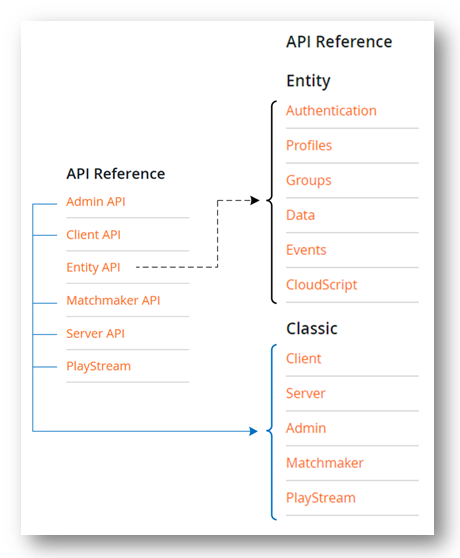Entity API restructure upgrade tutorial
Introduction
We have restructured the APIs that were lumped under the Entity API group into coherent logical groups that make their consumption easier, both via the documentation site, and the PlayFab SDKs.
The immediate impact is that if you have been using the entity-based APIs in your game, the code will need to be updated when you upgrade your SDKs.
Prerequisites
The following conditions must be true for this upgrade guide to apply to you:
- You're using the entity-based PlayFab APIs.
- You have upgraded to a PlayFab SDK, published on 8/9/2018 or later.
Note
There are no service level changes. For example, existing titles using old SDKs will work without requiring changes.
How to upgrade
The fundamental impact of this change is that the PlayFabEntityModel API group has been separated out into six different API groups that are logically bound together, as shown in the following picture.

A full list of Previous Entity API -> New API mapping can be found in APPENDIX 1 of this tutorial.
Note
The Classic API mapping has not been affected.
The next section will walk you through an example of upgrading a C# SDK using the PlayFabEntityAPIGroup to the new set of API groups.
Upgrade example: C# SDK
Please follow these steps to upgrade your application.
Step 1: Change any using statements that reference PlayFab.EntityModels such as those shown below.
using PlayFab.EntityModels;
using PlayFab.DataModels;
You can now be granular in your selection of which of these APIs you want to bring in, instead of importing the whole Entity API group.
Step 2: A more in-depth coding example of the New API, with comments in regard to how it looked before is provided below.
public async void Example()
{
var logrequest = new PlayFab.ClientModels.LoginWithCustomIDRequest
{
CustomId = "TestExample",
CreateAccount = true,
};
var loginResult = await PlayFab.PlayFabClientAPI.LoginWithCustomIDAsync(logrequest);
var playfabId = loginResult?.Result?.PlayFabId;
// PlayFab EntityAPI has been replaced here with the PlayFabProfilesAPI
// and PlayFab.EntityModels has been replaced with PlayFab.ProfileModels
var getProfileResult = await PlayFab.PlayFabProfilesAPI.GetProfileAsync(new
PlayFab.ProfilesModels.GetEntityProfileRequest());
var profile = getProfileResult?.Result?.Profile;
}
Follow suit for other SDKs, using the mapping from APPENDIX 1 in this tutorial.
Conclusion
We’re excited to expose the Entity APIs in a more intuitive way on our documentation site and in our code, based on your feedback.
If you have any questions and comments, please contact us via the PlayFab Forums.
APPENDIX 1: OLD to NEW API mappings
All of the APIs listed below were previously part of the PlayFabEntityModel API group. They're now categorized under the following new API groups.
PlayFabProfilesApi
- GetGlobalPolicy
- GetProfile
- GetProfiles
- SetGlobalPolicy
- SetProfilePolicy
PlayFabAuthenticationApi
- GetEntityToken
PlayFabDataApi
- AbortFileUploads
- DeleteFiles
- FinalizeFileUploads
- GetFiles
- InitiateFileUploads
- GetObjects
- SetObjects
PlayFabGroupsApi
- AcceptGroupApplication
- AcceptGroupInvitation
- AddMembers
- ApplyToGroup
- BlockEntity
- ChangeMemberRole
- CreateGroup
- CreateRole
- DeleteGroup
- DeleteRole
- GetEntityToken
- GetGroup
- InviteToGroup
- IsMember
- ListGroupApplications
- ListGroupBlocks
- ListGroupInvitations
- ListGroupMembers
- ListMembershipOpportunities
- RemoveGroupApplication
- RemoveGroupInvitation
- RemoveMembers
- UnblockEntity
- UpdateGroup
- UpdateRole
PlayFabEventsApi
- WriteEvents
PlayFabCloudScriptApi
- ExecuteEntityCloudScript